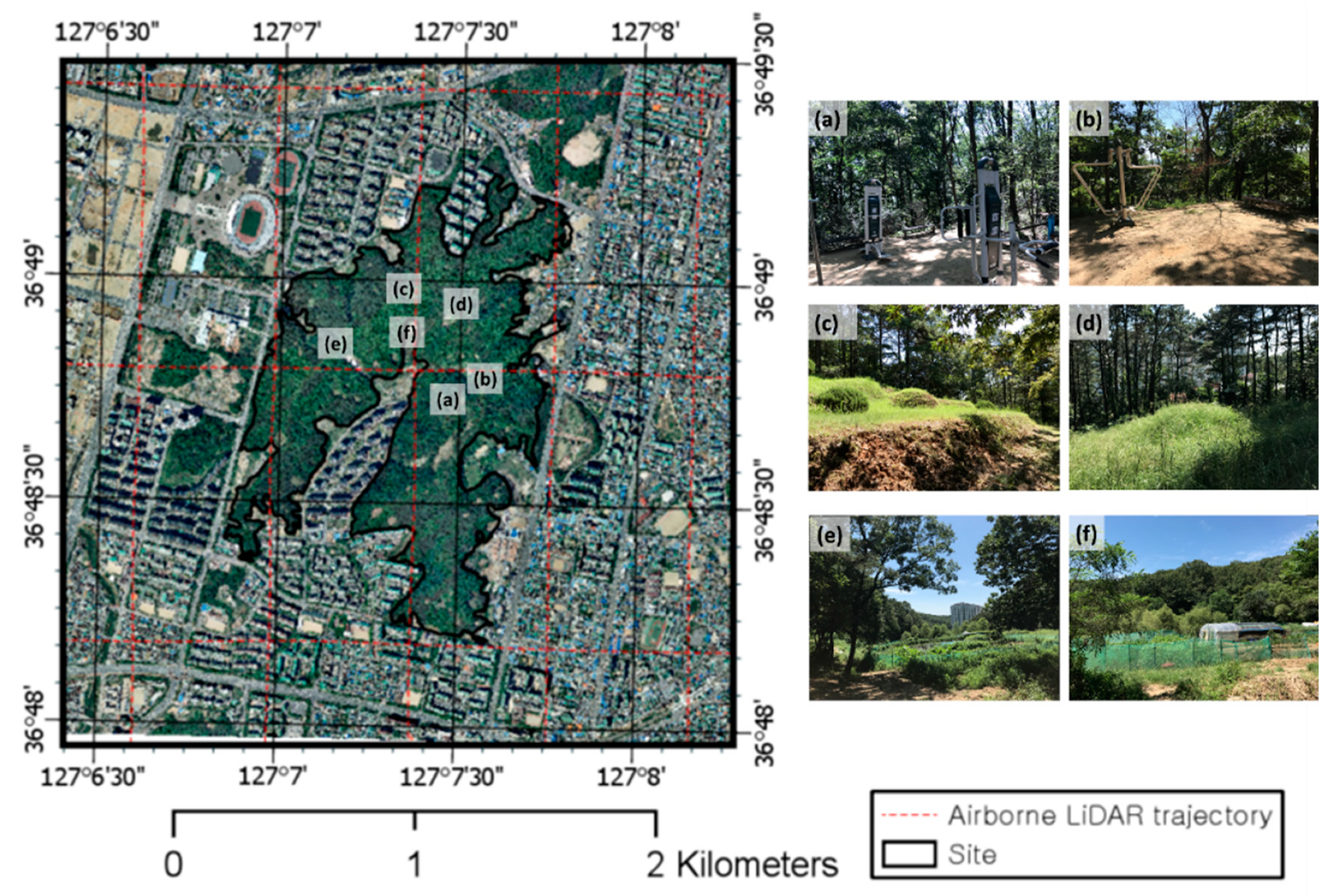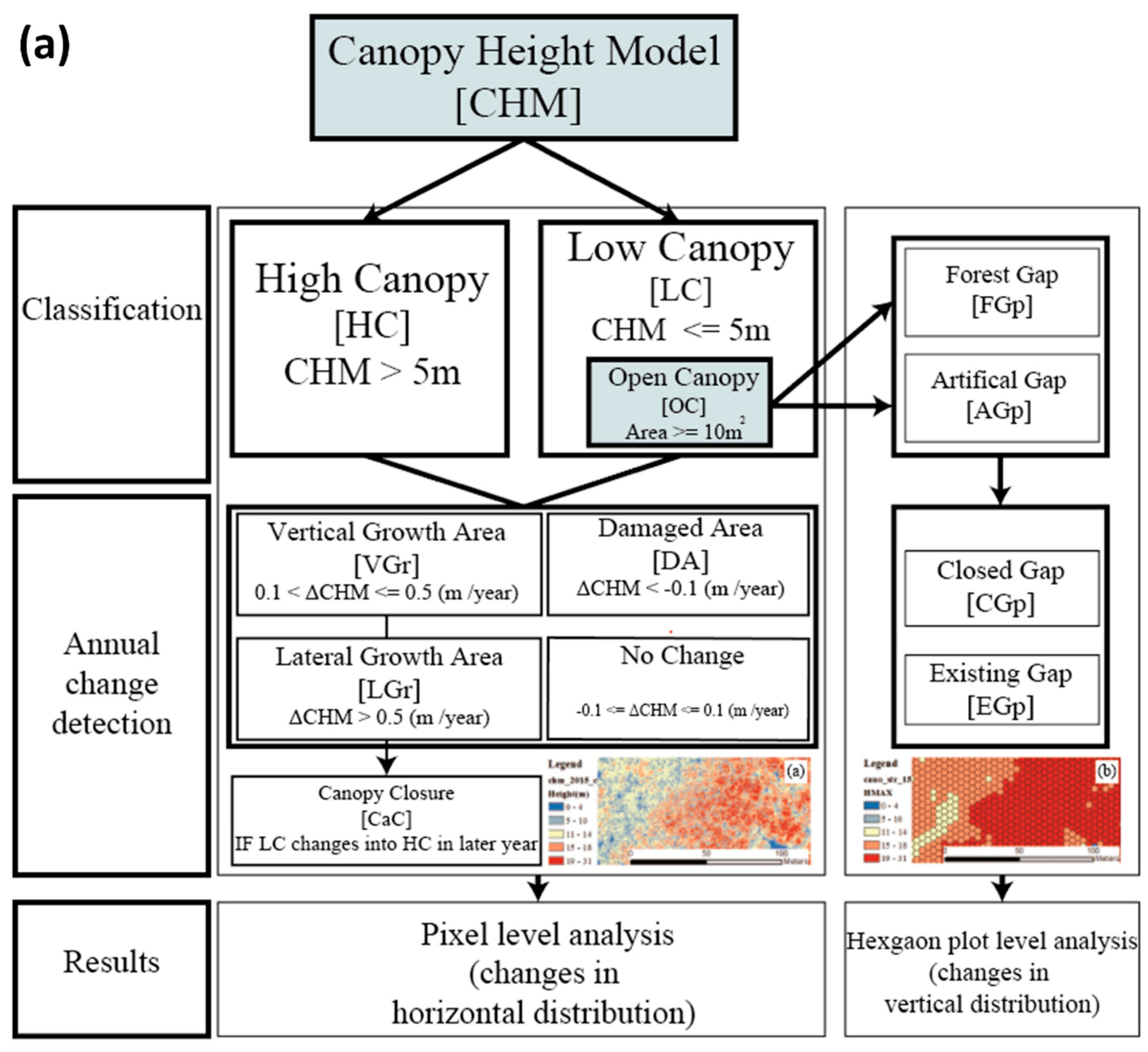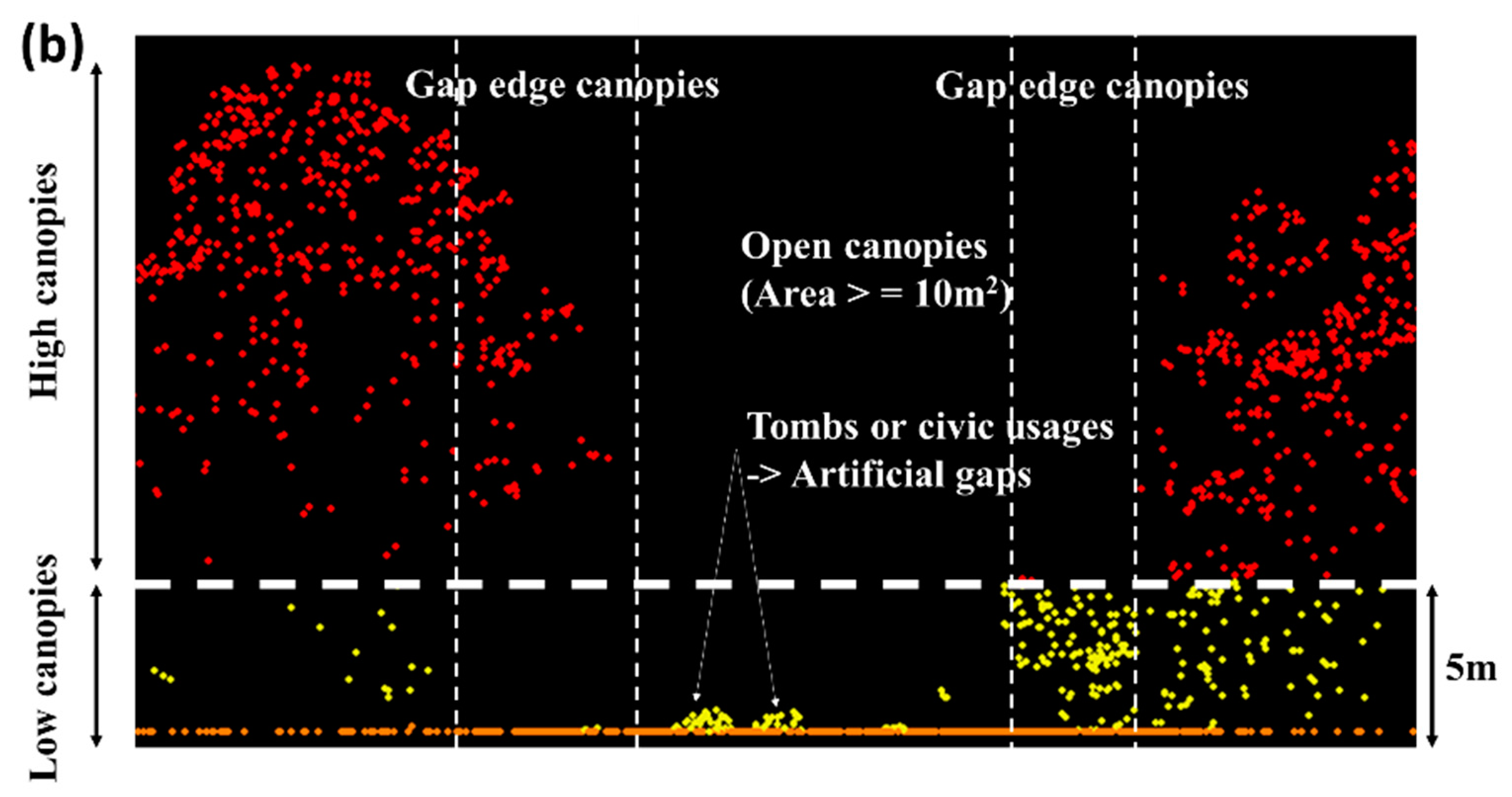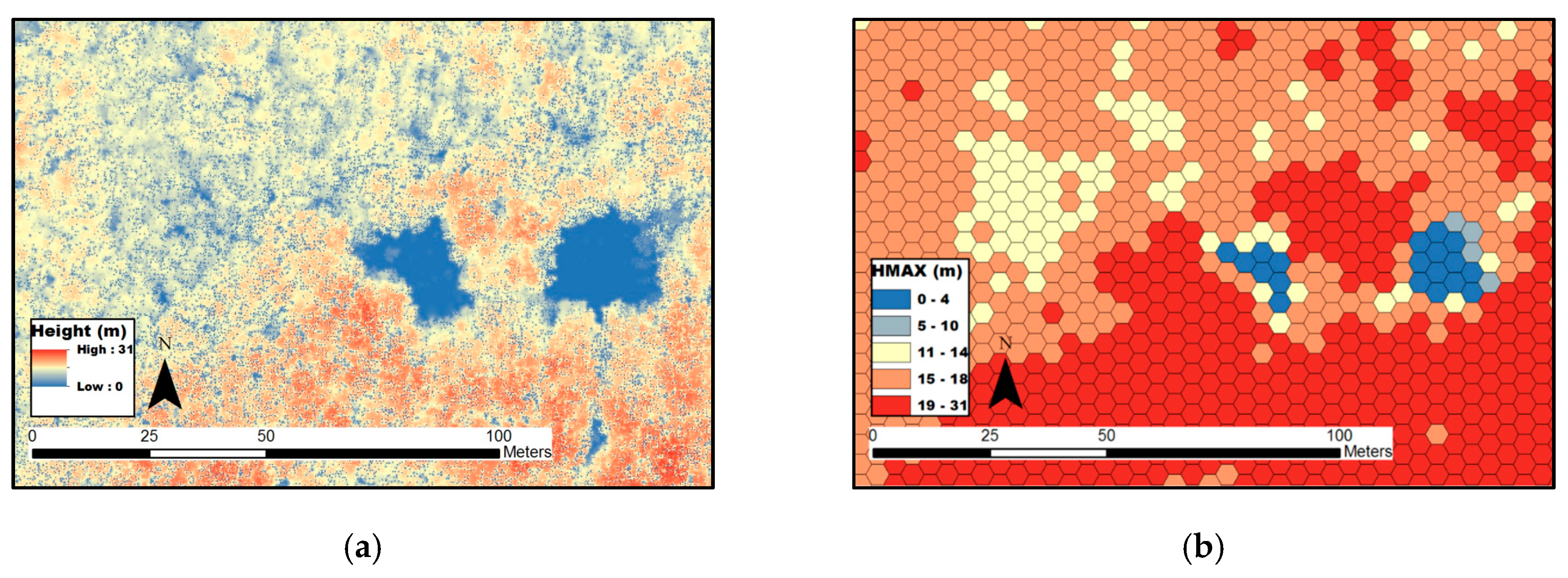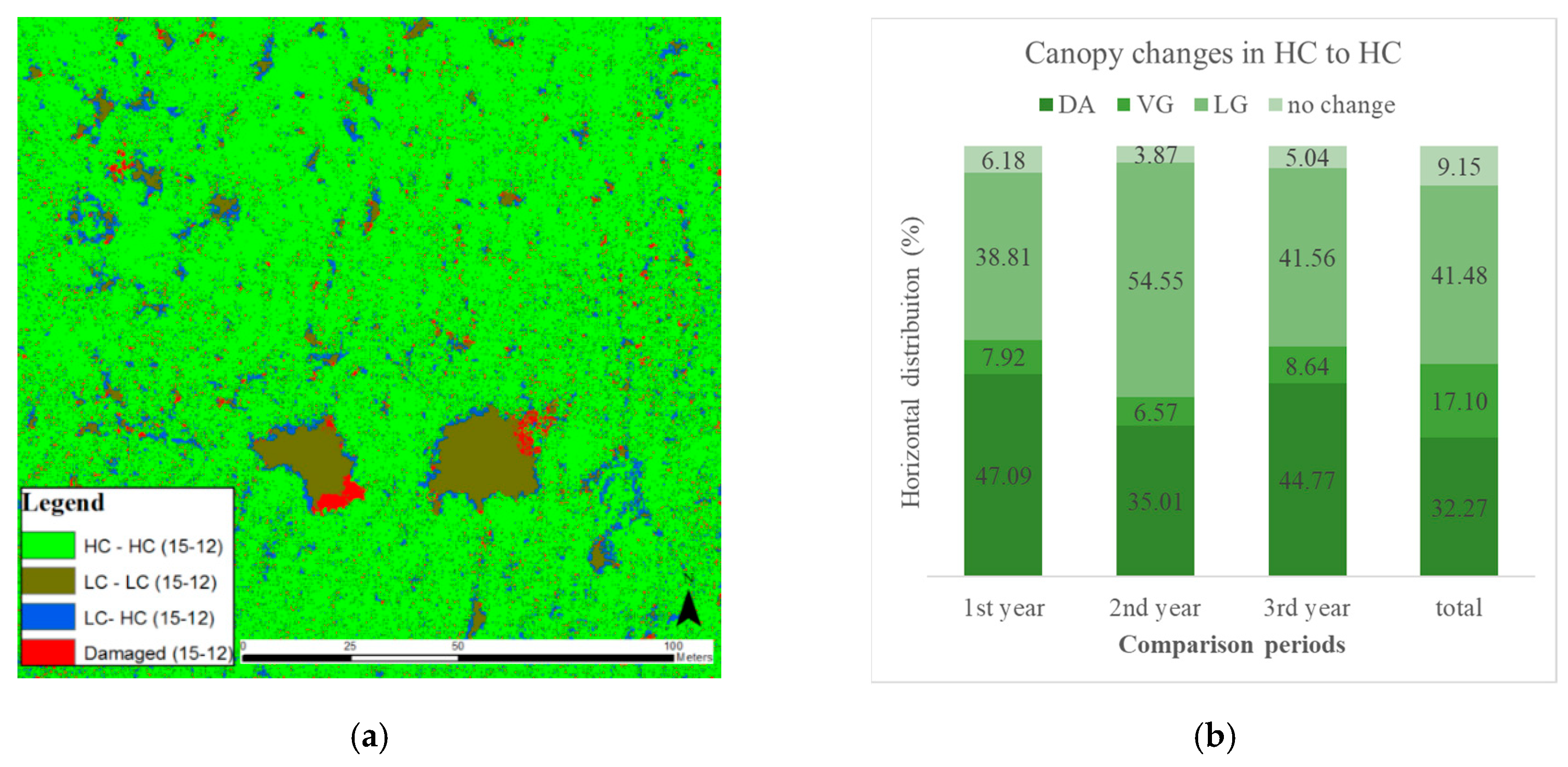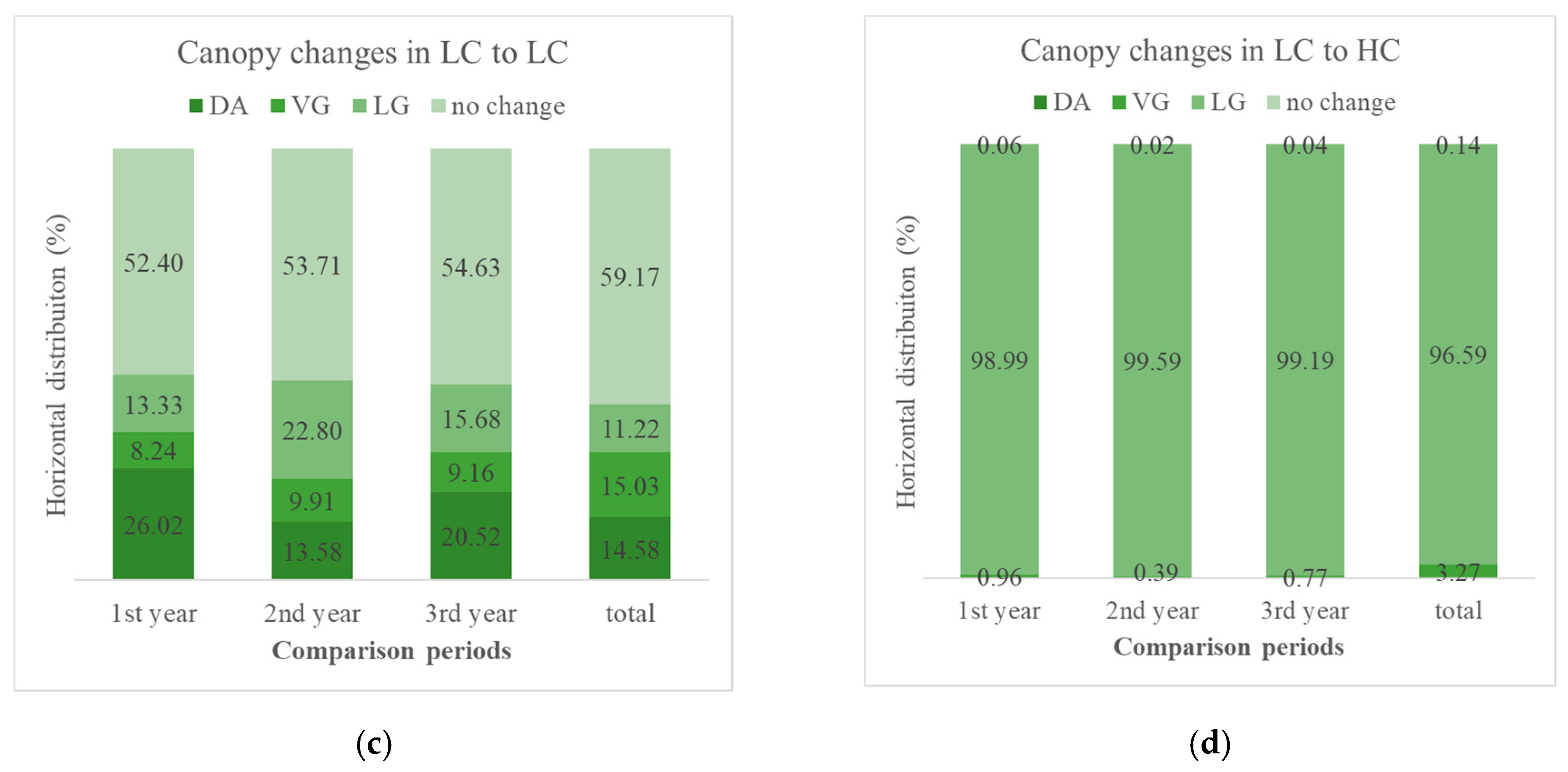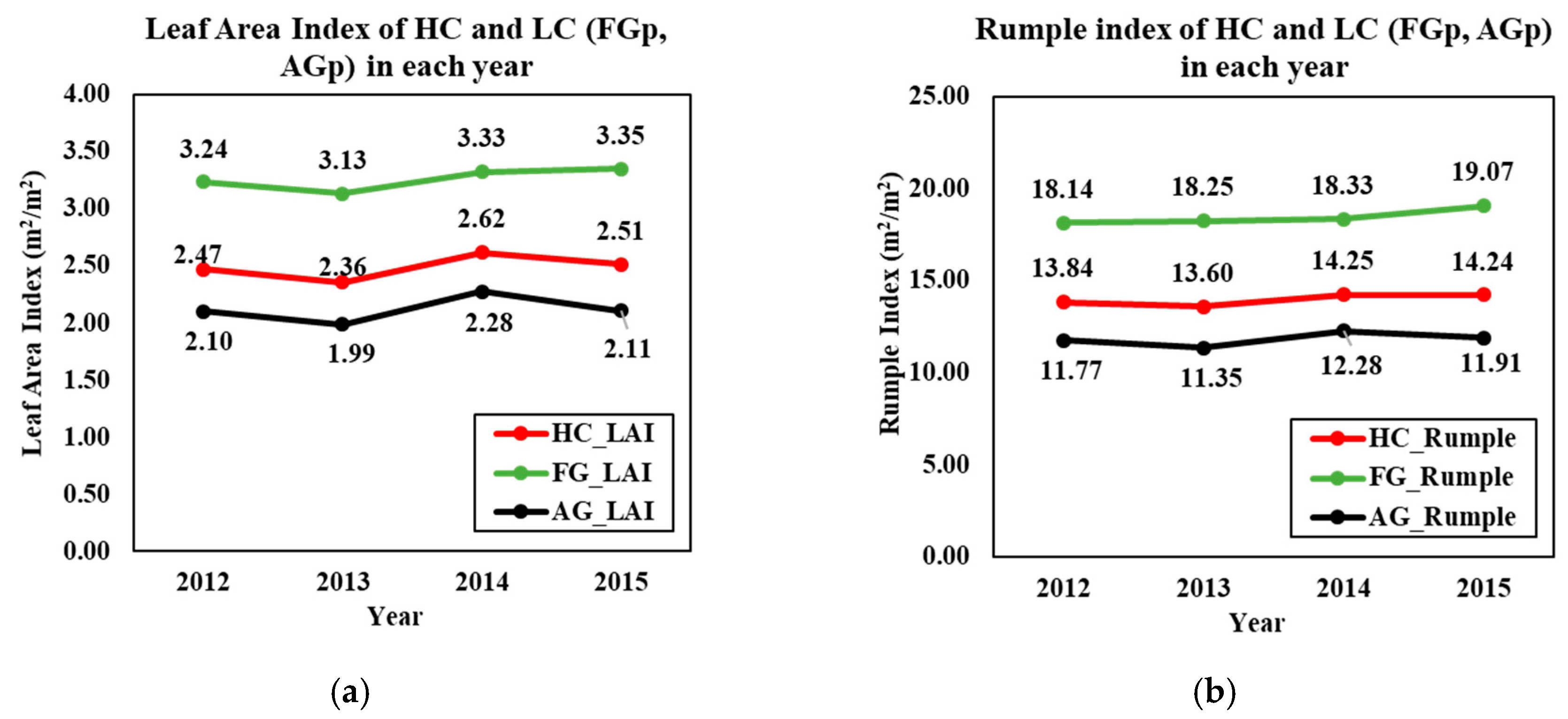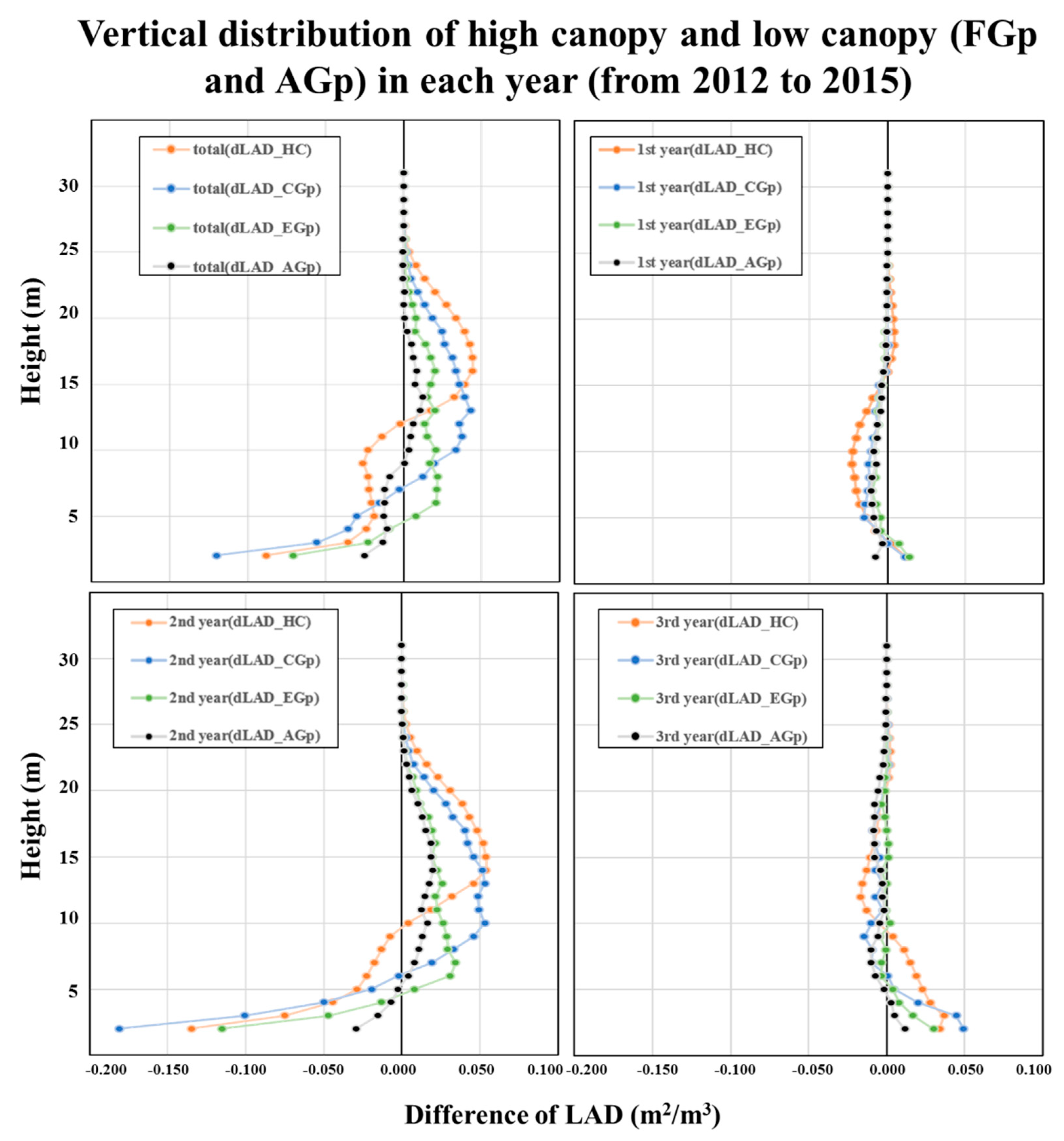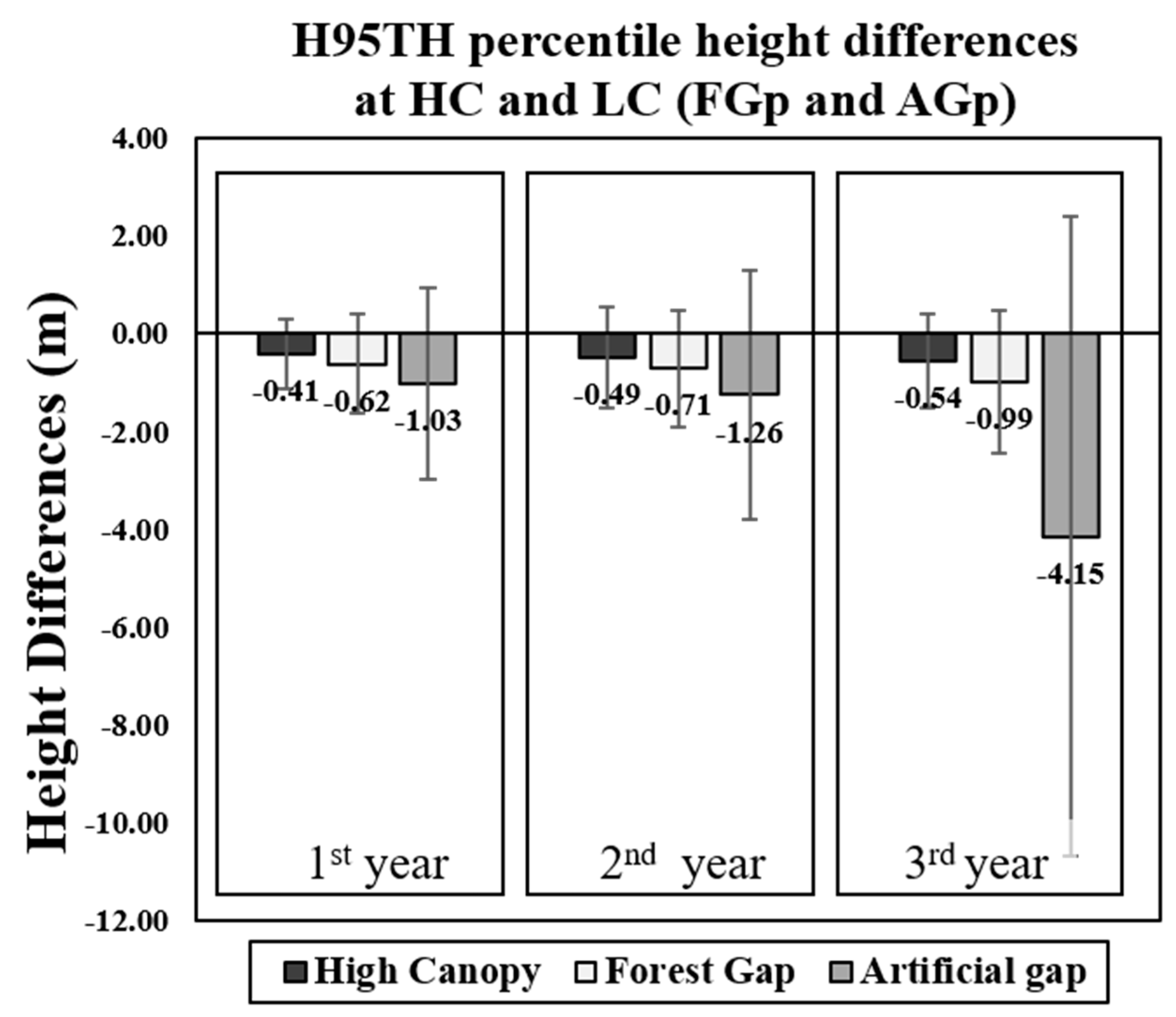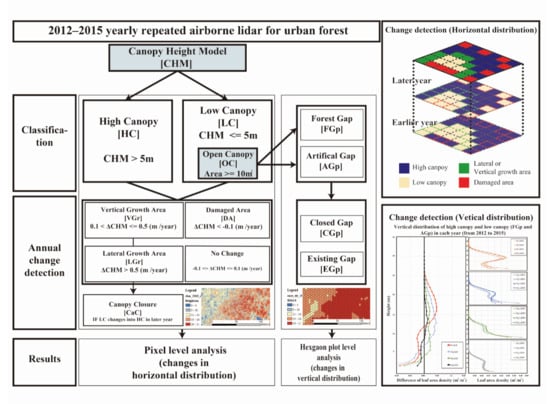1. Introduction
Quantifying forest gaps is essential for monitoring the stability of the forest structure because these disturbances can change the light environment and drive forest dynamics [
1,
2,
3,
4]. Physical disturbances in forest canopies usually result from deforestation (e.g., making space for agricultural fields) and tree-fall events [
1]. Forest gaps could be characterized by their size distribution. The frequency of forest gap areas in natural forests follows a power law distribution. Usually, small openings (formed by wind damage or tree mortality) in natural forests dominate areas in size distribution and show larger scaling exponents, while frequent large openings show smaller scaling exponents. Therefore, by comparing the scaling exponents with other forests, it is possible to compare the degrees of disturbances [
2,
3].
Urban forests are usually fragile to disturbances because the dense human population leads to severe conditions that can damage the forest directly (e.g., land-cover changes from forested to urbanized areas) [
5]. Forest damage such as deforestation and landcover changes could result in relatively larger openings than small openings in forests, and human activities therein may hinder the forest equilibrium or change the forest ecosystems [
6]. Particularly in South Korea, small and large mountainous urban forests are very common as they remain green areas after development, and many people use them for leisure activities, agriculture, and private graveyards that are accompanied with canopy openings [
7,
8,
9,
10,
11,
12]. Although many policies try to conserve these urban forests in South Korea, land use in urban forests is complex and can easily undergo harsh disturbances [
12,
13,
14]. Therefore, it is important to monitor forest gaps in urban forests where various natural or anthropogenic disturbances can occur.
Forest surveys are conducted in many countries via onsite sampling of plots that are considered representative of the whole study site. In addition, airborne photogrammetry and satellite imagery are applied to measure the diameter at breast height, stand height, basal area, and species composition using terrestrial field sampling data. However, these traditional methods have certain limitations related to the subjective interpretation of measurement results, low measurement accuracy, and lack of information about vertical canopy structures [
15,
16,
17,
18,
19,
20,
21]. To compensate for the limitations of existing research methods, there is a need to improve techniques that can support the assessment of forest growth and biodiversity such as airborne light detection and ranging (LiDAR) [
16].
Many studies have suggested that airborne laser scanning (ALS) can be applied to describe vertical forest structures, and the accuracy of stand height estimations has been assessed [
19,
21]. Although ALS-based tree height estimations are less accurate than those using rigorous field measurements [
22], the accuracy is acceptable, and the more efficient coverage of large areas by ALS offsets this weakness [
17]. Especially, Vepakomma et al. [
6] reported the difference between the effects of natural and anthropogenic linear openings (i.e., steam and roads) with LiDAR data. These days, with its acceptable accuracy and advantages in sensing vertical canopy structures, multitemporal LiDAR surveys have also shown great potential for detecting changes in forest structure [
23]. For example, the use of adequate multitemporal airborne LiDAR datasets represents a reliable and efficient method for detecting canopy changes and estimating canopy growth and forest biomass dynamics at a fine temporal resolution [
24,
25,
26,
27,
28,
29,
30,
31,
32,
33,
34]. Recently, Song et al. [
24], Zhao et al. [
29], Dalponte et al. [
30], and Cao et al. [
31] successfully estimated forest biomass dynamics and tree growth in forests using repeated airborne LiDAR data. Moreover, Dalagnol et al. [
32] and Rangel et al. [
33] reported quantification of canopy dynamics focusing on human-induced disturbances (e.g., logging) by using multitemporal airborne LiDAR data in Amazon forests. Rangel et al. [
33] reported that setting a height differences threshold was an efficient way to map logged trees and small gaps usually closed within short periods (within two years). Dalagnol et al. [
32] found that gap formation occurred more frequently in logged areas than in intact forests.
For applications of multitemporal ALS in urban forests, a few studies about the forest dynamics (e.g., forest growth and forest gap dynamics) in an urban forest have been conducted. Ossola and Hopton [
35] measured urban tree loss dynamics in city residential landscapes using bitemporal (five-year period) LiDAR datasets. They particularly noted the changes in urban trees over time caused by human management and urban tree removal for hazard prevention or artistic preference. Since urban forests are characteristically vulnerable to various and frequent disturbances, particularly in terms of physical damage [
4,
35,
36,
37,
38,
39], canopy loss occurs frequently and could finally result in artificial canopy openings. However, to the best of our knowledge, most studies with airborne LiDAR datasets have focused on forest gaps that are usually treefall gaps in natural forests [
26,
27,
28], and few studies are related to artificial canopy openings in cities. In the same manner of the effect on the surrounding environment of forest gaps, artificial openings could affect the adjacent environment [
32,
40] and may also affect the changes in surrounding canopy structures. Therefore, it is important to monitor urban forests continuously [
41,
42] including both forest gaps and their artificial canopy openings.
Thus, we estimated three-dimensional canopy changes in an urban forest using four years of annual LiDAR datasets. To assess how much urban forest structures have changed, we estimated: (1) the distribution of the growth area and damaged areas (e.g., vertical and lateral growth as well as damaged areas), (2) changes in the vertical leaf area density profile, and (3) the dynamics of opening and closing forest canopies during 2012–2015. Accordingly, this study addressed two questions: (1) What are the differences between canopy structure changes derived from annual change detections and three-year interval change detection? (2) What are the characteristics of structural changes by different canopy classes (e.g., high canopies and lower canopies) in urban forests?
5. Conclusions
In this study, we estimated three-dimensional canopy changes in an urban forest using four-year annual LiDAR datasets. Based on our results, we concluded that the vertical growth rates derived from one-year change detections showed similar values to three-year interval change detection. However, the regions in which the canopies grew up continuously differed according to the grid sizes (pixel- and plot-level grids), and they occupied only 15.9% and 38.9% of the growth areas detected in three-year interval comparisons. Moreover, the distributions in VGr, LGr, and damaged areas in the annual change detections showed irregular changes according to the year. These results might indicate that even though three-year interval (or larger) change detection could be a more efficient way to estimate the growth rates in a forest in terms of the costs and efforts, one-year interval change detection with airborne LiDAR datasets would be useful for monitoring and understanding what areas are vulnerable to disturbance (three-year interval change detection might detect open canopies as closed canopies).
We also concluded that the leaf area index showed consistent values year by year, while the leaf area profile (e.g., leaf area density) showed inconsistent yearly changes in both high and low canopies. Among the low canopies, we could conclude that they were vulnerable to physical damage, particularly in AGps. In the case of FGps, they also drove the growth and disturbance aspects of forest dynamics and served to diversify the canopy structure; most of them were closing in a lateral direction by gap-edge trees. Furthermore, high canopies expanded their foliage at a higher height (12 m) than those of low canopies (5 m).
Spatial-temporal distribution and gap characteristics could provide key information about what state these structures are in (e.g., close to natural forest state) vertically and horizontally through comparison with other forests. Moreover, based on the gap types (i.e., natural or human-induced openings), our results could guide management priorities, such as designing a conservation area or planning a restoration, by giving comprehensive information on which parts of a forest are vulnerable to disturbances or require better, more efficient management.
Although we found that one-year interval change detections showed the potential to achieve detailed information about canopy changes, further study is warranted. For example, since detecting changes in the distribution of canopies might be easily affected by the grid size and the DOY of data acquisition, an adequate grid size and DOY should be suggested. In particular, in the case of DOY, seasonal variations in the canopies over a year could be studied with a mobile LiDAR, and this may both hint at the DOY of data acquisition via airborne LiDAR survey and inform about seasonal changes in canopy structures.
